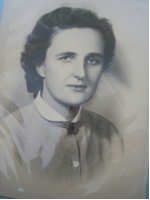
Read also Litany of Saint Gianna Beretta Molla
Gianna Beretta Molla, crowning an exemplary life as a student and a committed young woman in the ecclesial community, and as a happy wife and mother, knew how to offer her life as a sacrifice so that the baby she bore in her womb might live, and she is with us here today! As a surgeon, she was well aware of what to expect, but did not falter before sacrifice, confirming in this way the heroic nature of her virtues.
— John Paul II, homily for the beatification Mass of Gianna Beretta Molla, Vatican, May 1994
On October 4, 1922, a daughter was born to Alberto and Maria Beretta in Magenta, Italy. It was the Feast of Saint Francis, a special day for Gianna’s parents, who were both Franciscan Tertiaries. On October 11th, their daughter was baptized Gianna Francesca (Jane Frances) in the Basilica of San Martin. The name Gianna derives from the Hebrew, and means ‘God is gracious.’
Gianna was the tenth of thirteen children born to Alberto and Maria. Five of her siblings died in infancy. In the picture below, Gianna is the first on the right. From the top left in the photo we can see Ferdinando, Francesco, her father, her mother, Amalia (her elder sister who died in 1937 at the age of 27), Giuseppe, Enrico (Father Alberto), her grandmother Amalia De Micheli, Zita and Virginia.
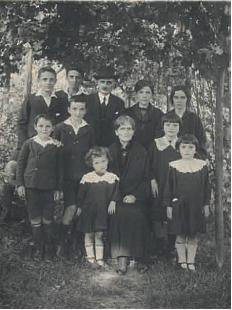
Gianna’s parents were devoted to each other and to their children. As sincere Catholics and Third Order Franciscans, they considered bringing up their children to be a fulfillment of the work of God in creating their children. Alberto worked in a cotton mill, and although the family was not poverty-stricken, they lived a materially frugal and simple life. Alberto and Maria were devoted to giving their children a rich spiritual and religious formation while willingly sacrificing so that their children could be educated in professions, and then carry their Christian faith into their communities through their work. Hence they gave up all unnecessary expenses – Alberto even one day abruptly quit smoking cigars – and provided a daily example of living faith. Described as a man of deep faith, piety, sincerity, strength and joy, Alberto got up at 5AM every day to go to Mass and start his day’s work in the name of the Lord. Maria too, was filled with faith, loving, and humble as well as strong, firm and decisive. Every day after her husband caught the train to Milan, where he worked, Maria attended Mass with the children. The family prayed the rosary together. The image of the Sacred Heart of Jesus was often enthroned in their home, and after praying the rosary, family members would renew their consecration to the Sacred Heart.
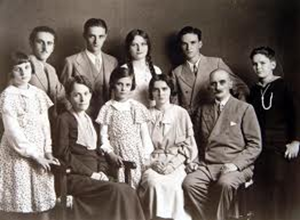
Although she had so many children to look after, Maria was able to attend to each child as though she had only one, helping them to understand their mistakes, and often able to correct them with only a glance. She even learned Latin and Greek to follow them in their studies. Eventually four of their surviving children would study medicine, two engineering, and one pharmacology. Three would consecrate their lives to God: her brother Enrico, who was both a doctor and a Capuchin missionary in Brazil; her brother Giuseppe, an engineer and priest in the diocese of Bergamo; and her sister Virginia, a doctor, Canossian sister and missionary in India. And one of their children – Gianna – would be canonized a saint. In this picture, Gianna is in the front row, first on the left.
Gianna’s younger sister Virginia recalled the atmosphere in the Beretta household:
“Never did a strong or uncontrolled word disturb the serenity of the family; never was a reproof from the mother without the support of the father or vice versa; always in accord, they loved their children and desired to give them a sound and complete formation. The atmosphere of the home was permeated with serenity and peace, but necessary punishment and corrections were never neglected.”
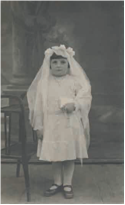
Brought up by parents who had full confidence in Divine Providence, and sensitivity to the poor and the missions, Gianna was immersed in an atmosphere of great faith and love for the Lord. She received her First Communion at the age of five-and-a-half, on April 4, 1928 (photo, right). From that day on, she received Communion every day of her life, considering the Eucharist to be her “essential food” for the day. On June 9, 1930, she received the Sacrament of Confirmation in the Cathedral of Bergamo. She was a calm child, never idle, who loved everything beautiful – music (she played piano), painting, and hiking in the mountains.
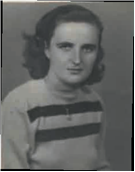
When she was 15-and-a-half years old, Gianna took part in a course of spiritual exercises at her Catholic high school, which had a profound affect on her spiritual life. She kept a notebook of the retreat, in which she wrote that she feared mortal sin as if it were a snake, and declared that she would rather die a thousand times than offend the Lord. She promised to submit to everything that God would allow to happen to her, desiring only to know His will. Gianna became more devoted to the Sacred Heart of Jesus, and found support in membership in Catholic Action, which stresses three key elements of our life in Christ: Eucharistic devotion, apostolic action, and heroic purity. Around this time, Gianna read about the life of Saint Maria Goretti, who died in defense of her purity. Gianna realized that purity is a virtue that requires great effort, but that purity, once attained, becomes beauty, strength and freedom, and she shared this insight with other young people in Catholic Action who looked to Gianna as a role-model. At this time Gianna was also beginning to think about devoting herself to missionary work.

Already in her young life, Gianna was familiar with suffering and sorrow. In 1937, Gianna’s dear sister Amalia died at the age of 26. Gianna herself had to suspend her high school studies from 1938–1939, because of frail health; this period, however, kept her at home with her parents, allowing her to know them better and imitate their virtues more closely. By 1941, Europe was at war and when Genoa — where the Berettas had been living — was bombed, the family moved to Bergamo. Two of Gianna’s brothers confirmed their vocation to the priesthood in the same year – a cause for joy. But then in 1942, within the space of four months, Gianna and her siblings lost both of their parents. Their mother Maria, who had a history of heart trouble, died on April 29th, age 55, followed by their 60-year-old father, Alberto, on September 10, 1942. In October, Gianna and her siblings moved to Magenta to her paternal grandparents’ home. There, Gianna was involved in the Society of Saint Vincent de Paul and Catholic Action. Gianna clearly took to heart Catholic Action’s commitment to prayer, action and sacrifice as a leader of young girls in the movement. Gianna also enrolled in medical school in Pavia, along with her sister Virginia.
During the time of her studies, Gianna was an active and outgoing young woman. She enjoyed sport, the theatre and – like most young girls – nice clothes. She was diligent in her studies, but equally devout in her faith, keeping up daily Mass and Communion, visits to the Blessed Sacrament, and praying the rosary.
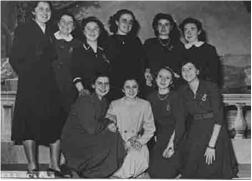
Along with her sisters, Gianna assisted the parish priest and helped with the education of the youth in the Oratory of the Canossian Sisters, and through her association with the Sisters of Saint Vincent, helped in their charitable outreach to the elderly and needy. She drew some members of Catholic Action into the St. Vincent de Paul Society with the aim of training them to help the poor, the sick, and the isolated elderly who lived alone in houses scattered around the countryside near Magenta. At a Catholic Action conference in 1946, Gianna spoke about the vocation to marriage: “To be called to family life does not mean getting engaged at the age of 14…. Now is the time to begin to prepare yourself for family life. You cannot follow this path if you do not know how to love. To love means to want to perfect yourself and your beloved, to overcome your egoism, and give yourself completely.” Gianna was leading the young members of Catholic Answers not only by words and the example of her life, but by her very character. One of her high school friends recalled Gianna at this time: “Gianna gave her smile, full of sweetness and calm, a serene and profound reflection of a soul in peace” [translated from Italian].
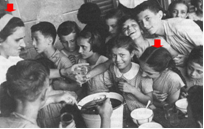
In November, 1949, Gianna received her degree in medicine and surgery. Because of delicate health, she ruled out the idea of going to Brazil as a missionary. Instead, Gianna opened a medical clinic in Mesero, and also donated her services as a doctor for children who attended a school run by religious sisters, and as a pediatrician in a summer camp. She continued her medical studies, obtaining a degree as a pediatric specialist in 1952. Patients confided their doubts, disappointments and fears in Gianna, and relied on her warmth and human compassion as well as good sense. Gianna’s professional life was deeply rooted in her faith; in every patient, she saw Christ: “Everyone works in the service of man. We doctors work directly on man himself…. The great mystery of man is Jesus: ‘He who visits a sick person, helps me,’ Jesus said…. Just as the priest can touch Jesus, so do we touch Jesus in the bodies of our patients…. We have opportunities to do good that the priest doesn’t have. Our mission is not finished when medicines are no longer of use. We must bring the soul to God; our word has some authority…. Catholic doctors are so necessary!”
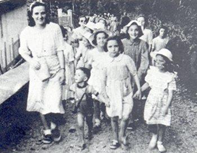
Sometimes her patients’ medical conditions were caused by a disordered moral life, which saddened Gianna greatly. She would use her position as the healer of their bodies to try to convince them to change their behavior. She dissuaded, with firmness and charity, women tempted to have an abortion. She would also make those who had already had an abortion understand the evil they had done and invite them to repent and open up to God’s forgiveness. Often, her poorer patients paid her in eggs or other produce; when they were too poor to pay, she would herself give them food or pay for their medicine. She explained, “If I give care to a patient who has nothing to eat, what good is the medication?” A note Gianna wrote about medical ethics while at a conference is prescient: “The doctor should not meddle. The right of the child is equal to the right of the mother’s life. The doctor can’t decide; it is a sin to kill in the womb.”
Gianna was by all accounts a happy, vibrant young woman, brimming with love of life and love of God. She balanced her work with a love of the outdoors and physical activity, especially skiing, hiking and rock-climbing in the Alps, feeling particularly close to God when at the top of a snowy mountain. She enjoyed the symphony, the opera, painted pictures and had decided tastes in clothing, preferring what was fine, understated elegant and modest.
Loving to the Point of Giving Your Life

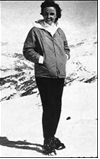
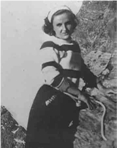

But with all of this, there was still an unresolved question in Gianna’s life: What was her vocation? Gianna prayed and thought deeply about God’s call on her life. She wrote, “Everything has a specific end; everything obeys a law. God has shown each one of us the way, the vocation, and the life of grace that lies beyond physical life. Our earthly and eternal happiness depends on following our vocation without faltering. What is a vocation? It is a gift from God — it comes from God Himself! Our concern, then, should be to know the will of God. We should enter onto the path that God wills for us, not by ‘forcing the door,’ but when God wills and as God wills….” Inspired by the letters sent by her brother, Father Alberto (baptized Enrico), who wrote of his many duties serving as a lone medical missionary in Brazil, Gianna had considered a dedicated single life, serving the sick as a doctor or as a medical missionary. But under the guidance of her spiritual director, Gianna came to realize that God called her to marriage and motherhood.
Gianna’s personal life took a new direction in 1954, when deep affection blossomed between her and Pietro Molla, an engineer, factory director and fellow member of Catholic Action, who was ten years Gianna’s senior. Gianna’s account of the events leading to recognition that Pietro would be her husband can be told in a few words. Nineteen-fifty-four was a Marian Year, and Gianna had gone on a pilgrimage to Lourdes, as a doctor accompanying a train of sick people. At Lourdes, she asked the Blessed Virgin to help her discern her vocation. She wrote to a friend, “I have been to Lourdes to ask our Lady what I shall do: to go to the missions or to marry. I reached home…and Pietro came in!” She knew that Pietro was the man God had called to be her husband.
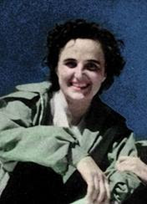
The two had met a few times before. Pietro seems to have recalled every meeting. The first time, they just saw each other and said, “Good-bye” when they met in a doctor’s office. Pietro found Gianna “clear and serious.” The second time was just after his sister’s blood transfusion. It was a painful time for Pietro; his sister would die in the next few days. He recalled seeing Gianna in her white coat, but only their eyes met. Writing as though speaking to his wife, in his deposition during Gianna’s canonization process, Pietro described the excellent impression he had of this extraordinary woman, whose path kept crossing his own:
“I already knew at that time that you were a good girl in every aspect: a student with a degree in medicine and at the same time very active in Catholic Action and the Conferences of St. Vincenzo [St. Vincent]. I was aware that, in your capacity as delegate of the area, you were also periodically in my parish, to give lectures to the youth of Catholic Action, in the same parish where I, then a graduate student, explained Christian doctrine to men and youths on Sunday afternoons. I remember my pastor, the good priest Don Giuseppe Airaghi, held you in high esteem. There was not one discordant voice among many people I approached, but only unanimous appreciation of the clear, exemplary witness of faith and Christian life of you and your family.
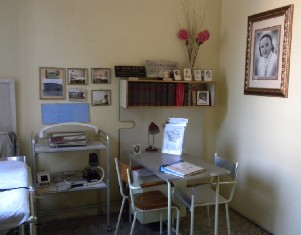
“I met you again in the summer of 1950, when you opened the clinic in Mesero and you chose as your nurse Mrs. Luigina Garavaglia, who lived in my own home. The second half of 1950 to November 1954, I recall some of our fleeting encounters, rapid exchanges of greetings and slight smiles…. I knew of the unanimous appreciation and esteem for you among all your ‘sick,’ young and old, especially young mothers and the elderly chronically ill who drew much comfort from your patient, loving, thoughtful care. All in Mesero knew you took meticulous care of your patients with competence and laudable commitment to their health and at the same time took a meticulous care even of the soul” (translated from Italian).
Clearly Pietro was deeply impressed by Gianna. But their meeting on December 8, 1954 — the Feast of the Immaculate Conception, and the 100th anniversary of the day on which Pope Pius IX solemnly defined the dogma of the Immaculate Conception — seems to have been the decisive moment in the attraction that was developing between these two devout professionals. Both had been invited to the first Mass of a mutual friend, Father Lino Garavaglia. Pietro was impressed by Gianna’s “sweet and bright” smile, her firm handshake, her reverent Sign of the Cross before breakfast, her prayer during Eucharistic Adoration. The next day Pietro wrote in his diary, “I feel the serene tranquility that gives me certainty that I had a good meeting yesterday. The Immaculate Conception has blessed me.” Pietro’s conviction that he had found the love of his life was confirmed a few weeks later, when he attended the ballet and welcomed the New Year with Gianna and her family in their home. On December 31st, he wrote in his diary, “This evening can be a decisive date for my life and my aspirations. I trust in Our Lady of Good Counsel” (translated from Italian).

For her part, Gianna fully embraced her vocation to marriage. Her letters to Pietro are touching, full of love, confidence in God, and the desire to create a Christian home and marriage. Gianna understood that love is a self-gift, and not a selfish desire to grasp after one’s own happiness. On February 21st, 1955, she wrote, “Dearest Pietro,… I want to make you happy and be what you desire: kind, understanding and ready for the sacrifices that life will require. I haven’t told you yet that I have always been very sensitive and eager for affection…. Now you are here whom I love, and I intend to give myself to you, to form a truly Christian family…” (translated from Italian).
In another letter of March 11, 1955, Gianna’s confidence in God’s help with her vocation is clear, and her prayer for her vocation might well become the prayer of any engaged woman: “Dear Pietro…I often ask myself, ‘Will I be worthy of him?’ Yes, worthy of you, Pietro, because I want so much to make you happy, but I fear not being able to do so, and I often feel I am unable to do anything. When this happens, I ask God, ‘Lord, you see my desire and my good will. Supply what is lacking and help me to become the wife and mother you desire and which I think Pietro wants, too’” (translated from Italian).
Pietro recalls his response to Gianna’s declarations of self-giving love: “From the beginning, and in almost every letter, she returned to this request: ‘Tell me what I should do to make you happy.’ It was not difficult for me to respond to her love. If her goal was to make me happy, what could I do but strive to make her happy?” He wrote to his fiancée, “My dearest Gianna…you are the strong woman I asked of heaven, and our heavenly Mother answered my prayer. I will always trust my whole heart to you and I will receive everything good from you. Love me always as you do now; always be affectionate and good, thoughtful and sweet and understanding as you are now. This is how you are already making me happy and how I ask you to make me happy always. To me you are the strong woman of the Gospel.”
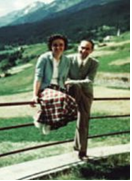
Eleven days before their wedding, Gianna wrote to Pietro her respect for him and vision of a holy marriage: “Dearest Pietro, I’m sure that you will always make me as happy as I am now and that the Lord will listen to your prayers, since they come from a heart that has always loved Him and served Him in a saintly way. Pietro, how much I have to learn from you! You are such a fine example for me, and I thank you for it. With God’s help and blessing, we will do all we can to make our new family a little cenacle [i.e., the “Upper Room” of the Last Supper and the Descent of the Holy Spirit] where Jesus will reign over all our affections, desires, and actions. My Pietro, our wedding is just a few days away now, and I feel very moved to be so near receiving the sacrament of love. We will be working with God in His creation; in this way we can give him children who will love and serve Him….”
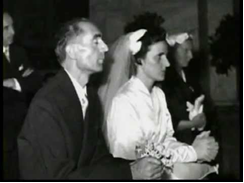
The official engagement of Gianna and Pietro was held on 11 April, 1955, Easter Monday, with a Mass celebrated by Gianna’s brother, Father Giuseppe. The wedding date was set for September 24th. Gianna confided to her sister Virginia, that in choosing her wedding gown, she wanted to choose the finest material, so that if she should be blessed with a son who was called to the priesthood, her wedding dress might be made into a chasuble for him to wear while celebrating Mass. To prepare themselves spiritually for receiving “the sacrament of love,” Gianna suggested that on the 21st, 22nd and 23rd, they celebrate a Triduum of attending Mass and receiving Communion, she in her parish church, and Pietro in his. She wrote, “Our Lady will unite our prayers, desires, and because unity is strength, Jesus can not but hear us and help us.”
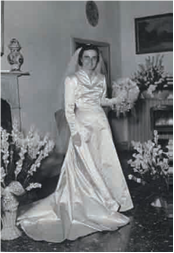
On the day of her wedding, in her white gown with a veil of tulle, Gianna entered the church on the arm of her brother Ferdinando. Pietro recalled that the entire congregation erupted into sustained applause as she made her way to the altar, where she and Pietro’s marriage was blessed by her brother, Fr. Giuseppe. Pietro recalled the congregation’s joy:
“The memory returns of that sudden outburst of applause that began upon your entrance to the church that lasted until you reached the altar. Your brother, Giuseppe, who blessed our union, exhorted us to give witness to the Gospel and to holiness.”
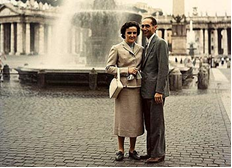
The couple honeymooned in Rome and travelled in Europe. A few weeks after the wedding, Pietro wrote to a friend, “Her holy virtue, the gentle goodness and affection of Gianna, all her cares, give me the full joy and serenity which I asked of Jesus on my wedding day. With Gianna I am sure of forming a truly Christian family on which she will know how to draw the most beautiful heavenly graces…. We have begun and will continue with perseverance the daily recitation of the Rosary. May our heavenly mother always watch over us and give us the grace to be cheered by little angels [i.e., children].”
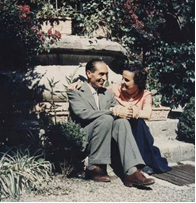
Gianna and Pietro settled in Pietro’s town of Ponte Nuovo, in a cozy cottage provided by the director of the firm that Pietro worked for. The house was quite close to the Church of our Lady of Good Counsel, where Gianna continued to pray and receive daily Communion at Mass. She counseled mothers at a home for mothers and children, as well as volunteering her medical skills in state nursery and elementary schools.
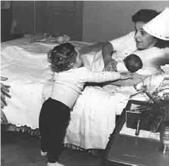
The couple was happy, and overjoyed to be blessed with the children they had prayed for. Pierluigi was born on 19 November 1956. A year later, Maria Zita (called Mariolina) was born on December 11 (in the photo, Pierluigi greets Mariolina just after her birth). Laura was born on 15 July 1959. All of the children were born at home in Ponte Nuovo; each was consecrated to the care of Our Lady of Good Counsel.
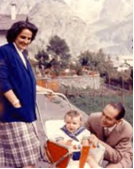
With simplicity and joie de vivre, Gianna balanced her duties as wife, mother and doctor, and took deep satisfaction in her motherhood. She continued to begin every day with Mass, and to end every day on her knees in prayer, with her husband, Pietro.
During Gianna’s process for canonization, Pietro, writing as to his wife, recalled the joy in living that Gianna brought to him in their marriage, as well as the example she was of how to live a full life as a Christian:
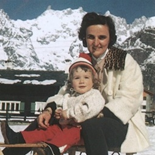
“You really knew how to enjoy in an upright and joyful way all the charms of the mountains and their snows, travel and concerts, the theater and party-going. You showed me that one can totally fulfill the will of the Lord and become a saint without renouncing the fullness of the purest and best joys that life and creation offer us.”
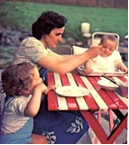
Gianna suffered two miscarriages before she conceived again. In September 1961, when she was nearing the end of her second month of pregnancy, she began to feel pain, and tests showed a large fibroid tumor in her uterus. She was given the option of an abortion, which would surely save her own life, or – more risky – an operation to remove the tumor, while trying to save the child. Gianna’s respect for life, her conviction that it is a sin to kill life in the womb, was being tested. Pietro recalled that Gianna told him explicitly, in a firm tone and at the same time clear, with a look that he would never forget, “If you must decide between me and the child, do not hesitate: choose – I insist – the child. Save him.”
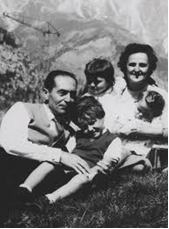
Pietro knew that it was possible he would lose his wife, and his three children would lose their mother. But he also knew Gianna’s generosity, her spirit of sacrifice, her thoughtfulness and the strength of her choices and decisions, and he knew he could only respect and honor her decision, even if it would mean a painful loss for him and his children. For Gianna, the little creature she was carrying beneath her heart had the same right to life as Pierluigi, Mariolina and Laura. She considered herself the instrument of Providence through whom her children had come into the world, and she was fully ready to join herself to divine Providence and rely on God in this crisis. She declared, “I am ready for everything, so long as my baby can be saved.” Her readiness for everything was based on God: in Him she would find strength to carry out her decision, no matter what the outcome for herself. She prayed with faith and perseverance, and insistently asked her friends for prayers, so she would be able to say “yes” to life.
In this frame of mind, Gianna had surgery on 6 September, 1961. The operation was successful. The tumor was removed, and the baby was not harmed. She lived out the remaining seven months of her pregnancy fully aware of the risk that the baby could be lost. A few days before her baby was due, she again charged her husband and doctors not to hesitate: if they had to make a choice between her life and the baby’s life, they should save the baby. As she had been seven months before, on the eve of giving birth, Gianna was ready to lay down her life that her child might live.
On 20 April, 1962, Good Friday, Gianna was admitted to hospital for the birth. At first it was hoped that she could give birth naturally, but then it was decided that a Caesarean section would be required. The next day – Holy Saturday – Gianna Emanuela was delivered. The baby was healthy and well, but her mother was not. Doctors discovered that Gianna had a severe infection. A day after the commemoration of Christ’s suffering and death, Gianna Beretta Molla’s own passion was beginning. Within a few hours Gianna developed a fever that raged higher and higher, while she suffered acute and excruciating abdominal pain as the septic peritonitis spread.
Gianna’s sister Virginia, who had finished her medical studies, entered a convent, and gone to India as a medical missionary, was providentially at home in Italy at this time, and could attend her sister. Sister Virginia recalled that Gianna rarely revealed how greatly she was suffering. She wanted to be aware of her suffering, and refused medicines that would obliterate her pain, because she wanted to be lucid in her relationship with Jesus as she followed him to the Cross. She constantly invoked Christ, saying, “If you knew what comfort I received by kissing the crucifix!” She drew strength from prayer, often uttering short expressions of love and tenderness, “Jesus, I love you, Jesus I love you;” “Jesus, help me;” “Mama, help me… Maria” followed by silent reflection.
Her husband Pietro was also at Gianna’s side. He recalled, “I remember when you told me, on Wednesday morning, with such solemnity, that it almost seemed otherworldly: ‘Pietro, I am cured now. Pietro, I was already on the other side, and if you only knew what I saw. Someday I’ll tell you. But since we were too happy, too comfortable with our marvelous children, full of health and grace and all of heaven’s blessings they sent me back to suffer some more, because it is not right to present ourselves before the Lord without having suffered much.’ This was and remains for me [her] testament of joy and suffering.”
Despite every effort from her doctors, daily Gianna’s condition and her suffering worsened. She wanted to receive Communion, as she had done every day since her first Communion 35 years before. But her illness made her vomit, and out of respect for the Eucharistic Lord, she was content only to receive a fraction of the host touched to her lips.
Gianna had discussed the possibility of her death with her brother Fernando. They had considered a question that would be asked if Gianna was near to death, and Ferdinando asked Sister Virginia to pose the question, “Courage, Gianna. Mama and Papa are in heaven waiting for you. Are you happy to go there?” Gianna gave no answer in words, but Sister Virginia recalled that by the movement of her brow she could read complete and loving adherence to the Divine Will. Gianna surrendered herself to the Father, as Jesus had surrendered Himself.
Gianna had told Pietro that she wished to die at home, and in accordance with her will, she was taken home, where she died on the Saturday in the Octave of Easter, at about eight o’clock in the morning.
Gianna Beretta Molla, wife, mother, and doctor, was 39 years old.
On Sunday, Gianna’s last child was baptized by her uncle, Fr. Giuseppe. She was given the name Gianna Emanuela: Gianna in honor of her mother, and Emanuela (‘God-with-us’) as an affirmation of faith of the presence of God in the family and in all their hearts. A steady procession of mourners passed through the family home to view Gianna at rest in her coffin, noting the serenity of her face – all sign of pain gone, and an expression of joy on her face.
Gianna Molla’s funeral on Monday, April 30, was marked by emotion, prayer and faith displayed by those whose lives she had touched. The church was overflowing with mourners who were convinced that heaven had gained a new saint. Sister Virginia wrote to her brother, Fr. Albert (baptized Enrico):
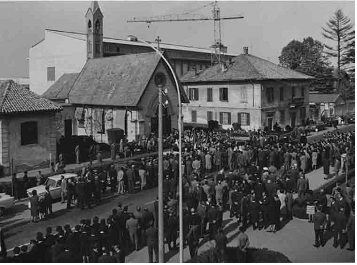
“The funeral has been more beautiful than one for a princess and an incentive to a strong return to God, to sacramental life. There were never so many Easter confessions as in these days. These men confided to the priest that they felt the need to go to confession before they dared look at the corpse of Gianna”.
Gianna had confided the care of her children to her sister Zita. At the funeral, Zita expressed her conviction that the manner of Gianna’s death, like the way she lived her life, was a witness to the will of God: “If the Lord called her to be with Him, it is because He wants to make her an example to many mothers who find themselves in such predicaments.” A fellow doctor, pediatrician Jolanda Botti, had a similar presentiment, saying, “I believe that the memory of Gianna will be a seed that will bear fruit. We cannot think that God has taken away from this world such a noble and dear lady without a very great motive that we cannot understand now.”
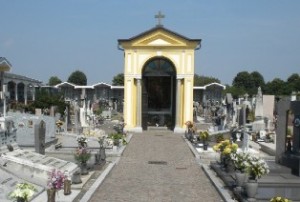
Gianna was buried in the cemetery in Mesero, and the story soon spread of her saintly life, crowned by her act of self-sacrificing love in carrying to term her last pregnancy, fully knowing that she was risking her own life for the life of her baby. Later, Gianna’s body was moved to a tomb and chapel designed by her brother, Giuseppi, who was also a civil engineer. Her husband Pietro, who died on 3 April 2010, is interred in the tomb along with Gianna, their daughter Mariola (d. 12 February 1964), Pietro’s sister Teresina (d. 1950).
Beatification and Canonization
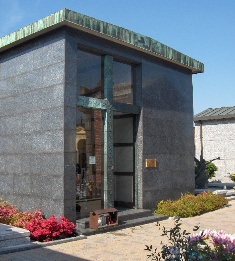
Eleven years after her death, on Sunday, September 23, 1973, Pope Paul VI spoke of Gianna Molla in his Angelus message. At a time when more and more countries were moving toward legalizing abortion and liberalizing abortion laws (the US had made abortion legal in January 1973), the Holy Father recalled the mother in “the Diocese of Milan, who in order to give life to her baby, sacrificed her own life…” by refusing an abortion early in a difficult pregnancy. In moving language, the Pope pointed to Gianna Beretta Molla as an example to a world all too ready to kill the unborn. And so Gianna Molla’s reputation for holiness continued to spread from her diocese to the whole church.
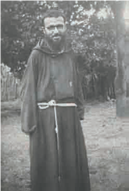
The process for beatification requires that a miracle can be attributed to the Servant of God in question, and this without any doubt, either scientific or theological. St. Gianna’s own brother, Fr. Alberto, the Capuchin Franciscan missionary doctor, was uniquely connected to the first miracle attributed to Gianna Molla, for it was at a hospital he had helped to found where the first miracle took place.
On October 22, 1977, in Grajau, Brazil, a young Protestant woman named Lucia Sylvia Cirilo had given birth to a stillborn baby by Caesarean section. It was her fourth child. After nine days, she was discharged from hospital in good health, and was able to resume her job as a housecleaner. But within a few days she began having pain. On November 9, the pain became acute, and her brother rushed her to St. Francis of Assisi Hospital. When she was examined, the doctors found a serious and unforeseen complication had arisen, which caused a rectal-vaginal fistula in the young mother. St Francis hospital was not equipped to handle the emergency: Mrs Cirilo would have to be transported to a hospital in Sao Luis, more than 600km away. The young mother’s condition was deteriorating rapidly, and doctors knew she would surely not survive the trip to Sao Luis.
One of the nurses in the Grajau hospital, Sister Bernardina de Manaus, a Capuchin Franciscan sister, was deeply distressed when she heard about Mrs Cirilo’s condition. She turned in prayer to Gianna Beretta Molla, hoping that through her intercession, the young mother would be healed and thus not need to make the trip to Sao Luis. Gazing at a small picture of Gianna Molla, sister of one of the hospital’s founders, she prayed, “You who are the sister of Father Alberto, make this fistula heal and keep this woman from having to travel to Sao Luis….”
Sister Bernardina asked two other nurses to pray to Gianna along with her. According to the testimony of the patient, at about the same time her pain subsided and disappeared. The surgeon was called in to examine Mrs. Cirilo, and to his amazement, he found that the fistula had completely healed, and it was no longer urgently necessary to transport her to the hospital in Sao Luis.
The next year, on April 23, 1978, the Archbishop of Milan and sixteen other bishops of the Lombardy Episcopal Conference petitioned the Holy See to open the cause of the beatification of Dr. Gianna Molla, a wife and mother they declared to be “an example fully relevant to our times in which the right to life is often disregarded and trampled upon.” The petition continued:
“This mother is a martyr and has given a sublime example of Christian heroism. For the love of God and in obedience to his commandment that forbids to kill, she has paid deep respect to life, which is always a gift of God to men, and has sacrificed her own young life to say ‘yes’ to the Christian law of love. It is the shining example of this woman — a wife and a mother — which we archbishops and bishops of the Lombardy region, would like, also in the name of our faithful, to propose today to the entire Church and to society in which, through selfishness and violence, it has become all too easy to kill, whether it is done in an open or in a hidden way. In this world of ours which is moving towards the legalization of abortion, the Servant of God Gianna Beretta Molla becomes a courageous example of Christian behavior.
“This example of lay sanctity, lived out in the marriage state as taught by Vatican II, will act as an encouragement for many Christians to seek God in their married life. They may be inspired by her and pray to her…. Her conscious sacrifice may throw light on the importance of the Christian family, Catholic schools, the Catholic Action for the formation of the Christian personality. It is in institutions such as these that the young Christian imbibes those Christian principles that will give a direction to his or her life and to which he or she will subordinate life itself, as Dr. Beretta has done with full awareness.
“Truly, heroism in Christian life is like a flower which rises at the top of a stem whose nature God alone knows perfectly, but which nevertheless makes us understand that every Christian vocation lived out according to God has an influence on the whole Church” (L’Osservatore Romano).
On March 15, 1980, Pope John Paul II signed the introduction of the cause for Gianna’s beatification, an inquiry was conducted into the heroic virtue of her life, and documentation was sent to Rome to the Congregation for the Causes of Saints. In 1991 a decree was issued attesting to Gianna’s heroic virtue and the validity of the first miracle attributed to her was proclaimed in 1992. Consequently, during the Year of the Family, 1994, Gianna Beretta Molla was beatified on April 24.
In his homily for Gianna’s beatification, John Paul II referred to Gianna’s deep conviction that love is self-giving, devotion, sacrifice, and that maternal love is a universal model of self-giving love. He described Gianna as “[a] woman of exceptional love, an outstanding wife and mother, [who] gave witness in her daily life to the demanding values of the Gospel. By holding up this woman as an exemplar of Christian perfection, we would like to extol all those high-spirited mothers of families who give themselves completely to their family, who suffer in giving birth, who are prepared for every labor and every kind of sacrifice, so that the best they have can be given to others” (Beatification Homily, translated from Italian).
Before Blessed Gianna could be canonized a saint, the Church required that a second miracle be reported, investigated, and declared valid. Again, the miracle would occur in Brazil, the mission country of Gianna’s brother, Fr. Alberto.
In 1999, Elizabeth Arcolino, a 35-year-old mother of three, was pregnant. In her first month of pregnancy, she had a serious hemorrhage but without losing her baby. An ultrasound on November 30th showed that the baby was developing in a gestational sac that was smaller than usual, and Elizabeth’s doctors doubted that her baby would be able to develop in her womb for the full nine months. In December, doctors discovered that a large blood clot had formed in her uterus, and that even though the baby was still developing, Elizabeth’s placenta had deteriorated. Her doctor said that it was almost certain that Elizabeth would miscarry or that the baby would die in utero and have to be removed. Nevertheless, the baby’s heart kept beating, and the pregnancy continued.
In February, Elizabeth felt that something was seriously wrong, and went to the hospital. It turned out that her membrane had broken: she was 16 weeks pregnant and had no amniotic fluid to cushion the baby from uterine pressure and prevent bacteria from the birth canal infecting both the mother and the child. Elizabeth was in serious danger, and her doctor recommended terminating her pregnancy. Nevertheless, in a desperate attempt to promote the formation of amniotic fluid, the doctor put Elizabeth on a regimen of intravenous hydration, but without success.
All medical research indicates that when the membrane ruptures and amniotic fluid is lost, within 60 days the pregnancy is spontaneously aborted. Doctors were sure that this would happen to Elizabeth, and encouraged her to have an abortion to avoid infection and save her own life. But Elizabeth was a faithful Catholic, and she knew in her heart that she had to do everything to try to give life to her child. When doctors told her to abort, she was distraught and crying, and requested a priest. Her faithful husband Carlos Cesar called the local priest, Fr. Ovidio Jose Alves di Andrade. Meanwhile, the doctor promised to return in 15 minutes with documents authorizing an abortion.
At the same time, a friend of Elizabeth’s named Isabel was visiting her. Inspired by her faith, she went immediately to the hospital chapel to pray to the Blessed Virgin to bring clarity to the terrible situation that Elizabeth found herself in. After her prayer, as she was leaving the chapel, she was surprised to run into the local Bishop, Diogenes Silva Matthes, who was at the hospital to visit another patient. Isabel stopped the bishop and informed him of her friends’ distress. She was surprised to discover that the bishop knew Elizabeth and Carlos; indeed, he had officiated at their wedding. The bishop immediately went to Elizabeth’s room and heard the whole story from her own lips. He told Elizabeth, “We will pray and God will help us.” The bishop asked the doctor to give them more time, and he left the room. While the bishop was out, Fr. Ovidio arrived and anointed Elizabeth with the sacrament for the sick. When Bishop Silva returned, he had with him a biography of Blessed Gianna. He told Elizabeth, “Do what Blessed Gianna did, and, if necessary, give your life for the child. I was praying at home and I said to the Blessed in prayer, ‘Now has arrived the opportunity for you to be canonized. Intercede before the Lord for the grace of a miracle and save the life of this little child.’”
Elizabeth, who was a catechist, already knew about Saint Gianna’s life and death. She also knew that the first miracle attributed to Saint Gianna had happened in Brazil. During her third pregnancy, Elizabeth – who had delivered her first two children by caesarian section – decided to try having a natural delivery. She was afraid of what might happen, but Bishop Silva had given her a holy card of Blessed Gianna and recommended that she pray to Gianna for help. Elizabeth prayed – and gave birth, naturally, to a healthy child. Inspired by Saint Gianna and strengthened by her past experience, Elizabeth decided to continue with her pregnancy as long as her child’s heart continued to beat. At this point, even Elizabeth’s doctor was beginning to have doubts that abortion was the best solution. She later said, “I don’t know if it was by intuition, through my own lack of courage, or if I was drawn by Elizabeth’s faith which seemed to have no limit, but I decided to wait and see what happened.” To Elizabeth, already a miracle had occurred: her doctor had been determined to perform an abortion, but Jesus had changed the doctor’s heart. Later Elizabeth testified that the doctor said to her, “Your faith has made me think a great deal. Even I have faith now so let’s wait for the death of the fetus.”
Elizabeth was discharged from the hospital, and went to stay with her husband’s aunt, who was a nurse. She had an ultrasound instrument to monitor the child’s heartbeat; she had to have her temperature and blood pressure checked every six hours; she was intravenously hydrated and started a treatment to help prevent problems with her baby’s lungs. She was monitored very closely, to see if any amniotic fluid accumulated, but there was none.
Meanwhile, her story had got out, and Fr. Ovidio later testified that the whole community was praying to Blessed Gianna asking for a miracle. Nearby Carmelite nuns began praying, and alerted their convents throughout Brazil to pray for Elizabeth, who – despite her faith – was having a difficult time. She was afraid she would die with her child; she worried what would happen to her other three children if she died, and she sometimes felt alone and abandoned by God.
Sixteen weeks after Elizabeth lost her amniotic fluid, the heart of her baby continued to beat beneath her own heart, and her baby had grown to 1.80 kilograms. On May 31, 2000, in her thirty-second week of pregnancy, Elizabeth was delivered of a daughter by caesarean section. She named her Gianna Maria, after her heavenly intercessor. Gianna Maria was completely healthy except for a twisted foot that probably developed because of compression within the uterus from the lack of amniotic fluid. The defect was later corrected with an operation and physical therapy.
Elizabeth’s own problems were not over, however. Because of complications, she had a severe hemorrhage – losing more than 75% of her blood – and she went into shock. Her kidneys shut down, her lungs collapsed, and she was drifting into a coma. She had multiple blood transfusions, and after three days, she recovered. Gianna Maria, meanwhile, put on weight, was examined and found to be normal, healthy, intelligent, lively and with a strong personality, as though her gestation had been normal and uneventful. She was able to go home on June 17.
The case of the miracle was carefully studied, and the decree “super miraculo” was promulgated in December 2003. Gianna Beretta Molla was canonized on May 16, 2004. Her own family and the entire Arcolino family were present at the canonization to hear Pope John Paul II say:
“Gianna Beretta Molla was a simple, but more than ever, significant messenger of divine love. In a letter to her future husband a few days before their marriage, she wrote: ‘Love is the most beautiful sentiment the Lord has put into the soul of men and women.’
“Following the example of Christ, who ‘having loved his own… loved them to the end’ (Jn 13:1), this holy mother of a family remained heroically faithful to the commitment she made on the day of her marriage. The extreme sacrifice she sealed with her life testifies that only those who have the courage to give of themselves totally to God and to others are able to fulfill themselves.
“Through the example of Gianna Beretta Molla, may our age rediscover the pure, chaste and fruitful beauty of conjugal love, lived as a response to the divine call!” (Canonization homily).
Saint Gianna’s feast day is April 28, the date of her death.
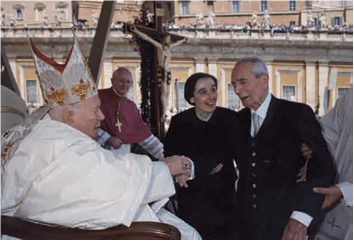
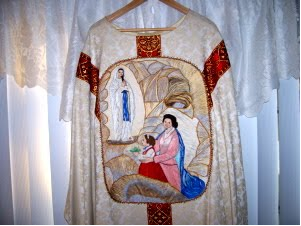
The Society of Saint Gianna (whose website provided much information in this article) obtained a piece of Gianna’s wedding dress from Pietro Molla, and pieces of the material were used in the creation of a chasuble. The picture of the chasuble shows Saint Gianna and her daughter Mariolina, who died a few years after Gianna. They are depicted kneeling before our Lady of Lourdes. Lace from Saint Gianna’s dress is sewn around the cuffs of Our Lady’s dress, and around the neck of the dress worn by Mariolina. Although Gianna’s son did not become a priest, the chasuble has been worn by many priests during Mass and at presentations when talks about Saint Gianna are given and people venerate her relics.
Prayer of St Gianna
Jesus, I promise You to submit myself to all that You permit to befall me, make me only know Your will. My most sweet Jesus, infinitely merciful God, most tender Father of souls, and in a particular way of the most weak, most miserable, most infirm which You carry with special tenderness between Your divine arms, I come to You to ask You, through the love and merits of Your Sacred Heart, the grace to comprehend and to do always Your holy will, the grace to confide in You, the grace to rest securely through time and eternity in Your loving divine arms.
Love is the most beautiful feeling that the Lord has placed in the minds of men…. To love means to have a desire for perfecting oneself and the person one loves, to overcome one’s own egoism and to give oneself. Love must be total, full, and complete, governed by the law of God and must become eternal in heaven.
— St. Gianna Beretta Molla
Read also Litany of Saint Gianna Beretta Molla
